Additional information
| Weight | 1 lbs |
|---|---|
| Dimensions | 4 × 4 × 4 in |
Our 2024 plant list will be available in mid-Febrary 2024. Orders will begin to ship in May - June 2024 Dismiss
$15.00
Asclepias physocarpa (Gomphocarpus physocarpus) is a unique milkweed and favorite with Monarch Butterflies as a milkweed host. It is grown as an annual throughout the United States except in USDA Zones 8-10. This milkweed is commonly known as Hairy Balls,
Swan plant, Balloon plant, Oscar milkweed, and Family Jewels. Native to South Africa, Asclepias physocarpa has become a favorite with American gardeners in butterfly gardens.
All of our plants are grown without the use of harmful pesticides and are safe for developing larvae.
Grown in 4.5” square pot.
Available Mid-May 2017
Out of stock
| Weight | 1 lbs |
|---|---|
| Dimensions | 4 × 4 × 4 in |
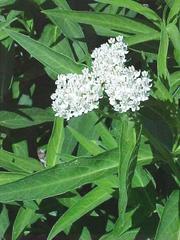
‘Ice Ballet’ is an elegant, long-blooming, bright white cultivar of native Asclepias incarnata (Swamp Milkweed) and features a compact habit and dark green foliage. Swamp milkweed occurs throughout most of the United States. It is a tall plant found in moist habitats such as wet meadows, floodplains, riverbanks, pond shores, stream banks, wet woods, swamps, and marshes, although it will also grow in drier areas such as prairies, fields, and roadsides. Asclepias incarnata needs full sun or partial shade to flourish. Flowers are very attractive to butterflies and bees as a nectar source. Swamp milkweed is also an important food source for the larval stage of Monarch butterflies. The plants are deer resistant and heat tolerant.
Available – May 2017
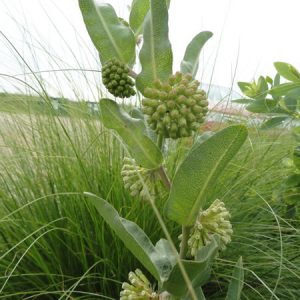
Asclepias viridiflora Short Green Milkweed is a Michigan native milkweed. While somewhat rare it has an extensive range throughout the United States. The plant matures to 1-3′ in height making it a nice choice for borders. Short Green Milkweed blooms during early summer with blooms lasting about three weeks. Flowers are light green to green and as the plant matures the flowers begin to turn yellowish green or purplish green. It prefers full to partial sun and grows in a variety of soils but prefers dry-mesic to mesic. Habitats include openings in upland forests that are rocky or sandy; upland black soil prairies, sand prairies, gravel prairies, and hill prairies; barrens, limestone glades, and sand dunes; and abandoned fields.
The flowers attract bumblebees and butterflies. Also known as Green Milkweed, Green Comet Milkweed, Green Antelopehorn Milkweed, Green-Flowered Milkweed.
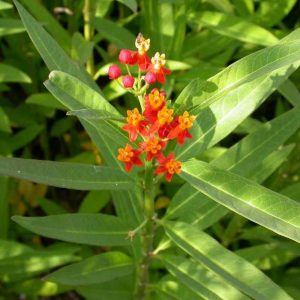
Tropical Milkweed, also known as Blood flower, is a tender evergreen perennial in the dogbane and milkweed family. It is native to South America, but has naturalized worldwide in many tropical and subtropical areas. It has a much longer flowering period than the perennial milkweeds that are winter hardy in Michigan. Showy red-orange flowers bloom late spring through late autumn except in USDA Zones 9-11 where it is winter hardy. Grows best in light, rich, evenly moist, well-drained soil in full sun. Will tolerate light shade and some soil dryness. Hummingbirds, butterflies and bees are attracted to the flowers. Monarch butterflies lay eggs on this plant and the resulting larvae (caterpillars) use the plant leaves as a food source. Flowers are followed by long, narrow seed pods (3-4” long) which split open when ripe releasing silky tailed seeds for dispersal by wind. Stems and leaves exude a milky sap when cut or bruised. Plants can be poisonous to livestock. Consider wearing gloves when working with these plants because the milky sap is poisonous if ingested and can be toxic to human skin.
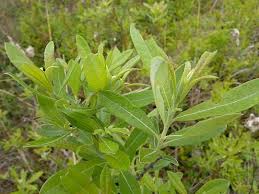
This shrub is 2-8′ tall, often branching near the base and toward the tips of older stems. Woody stems are terete and variably colored – usually some shade of yellowish tan, brown, or gray. Young woody stems are often short-pubescent, but they become glabrous with age. New shoots are light green and short-pubescent. Alternate leaves occur along young stems and shoots. The leaf blades are 1¾-4″ long and ¼-¾” across; they are narrowly lanceolate, oblanceolate, or oblong-elliptic in shape and smooth to slightly crenate along their margins. The margins are often revolute (curved downward) as well. The upper surface of the leaf blades is medium green or grayish green and glabrous to sparsely short-pubescent, while the lower surface (for this variety of Prairie Willow) is short-pubescent and sometimes whitened. The petioles are ¼-½” in length and short-pubescent. At the base of the petioles, lanceolate stipules are sometimes found.
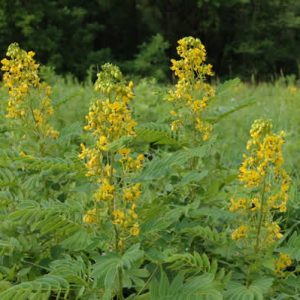
Host Plant – Sulphur, Clouded Sulphur, Orange Sulphur
Wild Senna is a versatile plant that we think deserves more recognition as a great choice for garden or restoration projects. Its lovely, bright yellow flowers bloom July-August, attracting many bees and butterflies. Autumn brings beautiful leaf colors and the formation of long black pods with seeds favored by larger birds like wild turkeys. A horizontal root system provides strength against winds, allowing the plant’s stately (4-6′) beauty to be appreciated even after the storm. Some gardeners use this sun-loving plant to form a hedge.
It is virtually indistinguishable from its relative, Maryland Senna (Senna marilandica) until the two species have ripe seeds. The Wild Senna will readily open its pod and the seeds will fall out, whereas the Maryland Senna seed pods will stay tightly closed. Other than this, it is very hard to tell the two species apart.

Spicebush is a deciduous shrub with a broad, rounded habit which typically grows 6-12′ (less frequently to 15′) high in moist locations in bottomlands, woods, ravines, valleys and along streams. Clusters of tiny, apetulous, aromatic, greenish-yellow flowers bloom along the branches in early spring before the foliage emerges. Dioecious (male and female flowers on separate plants), with the male flowers being larger and showier than the female ones. Flowers of female plants give way to bright red drupes (to 1/2″ long) which mature in fall and are attractive to birds. Female plants need a male pollinator in order to set fruit, however. Drupes are very attractive, but are largely hidden by the foliage until the leaves drop. Thick, oblong-obovate, light green leaves (to 5″ long) turn an attractive yellow in autumn. Leaves are aromatic when crushed. The larva (caterpillar) of the spicebush swallowtail butterfly feeds on the leaves of this shrub.Lindera is named for the Swedish botanist, Johann Lindler.
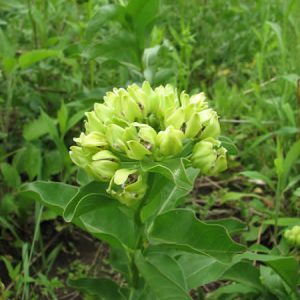
Spider Milkweed is also commonly known as Green Antelopehorn Milkweed. In Texas, it is quite common and is considered an important food source for the Monarchs as they start their spring migration northward. Spider Milkweed has a native range of Texas north to Nebraska and eastward as far as West Virginia and South Carolina. It can be found along roadsides, ditches, prairies, open areas, and other areas with little vegetative competition. This species tends to be short (12 inches) with multiple stems emerging from the root crown of mature plants. Taller, more erect plants, usually with one or a few stems, can be found in moist prairies. Spider Milkweed features rose-white flowers surrounded by green that form in showy umbellated clusters, often one per plant.
Available – May 2017
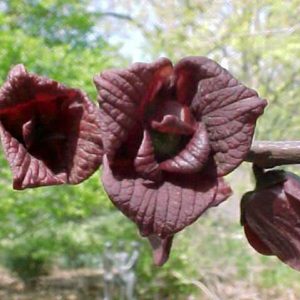
Easily grown in average, medium to wet, well-drained soil in full sun to part shade. Prefers moist, acidic, fertile soils. Will grow in shade but becomes leggy.
